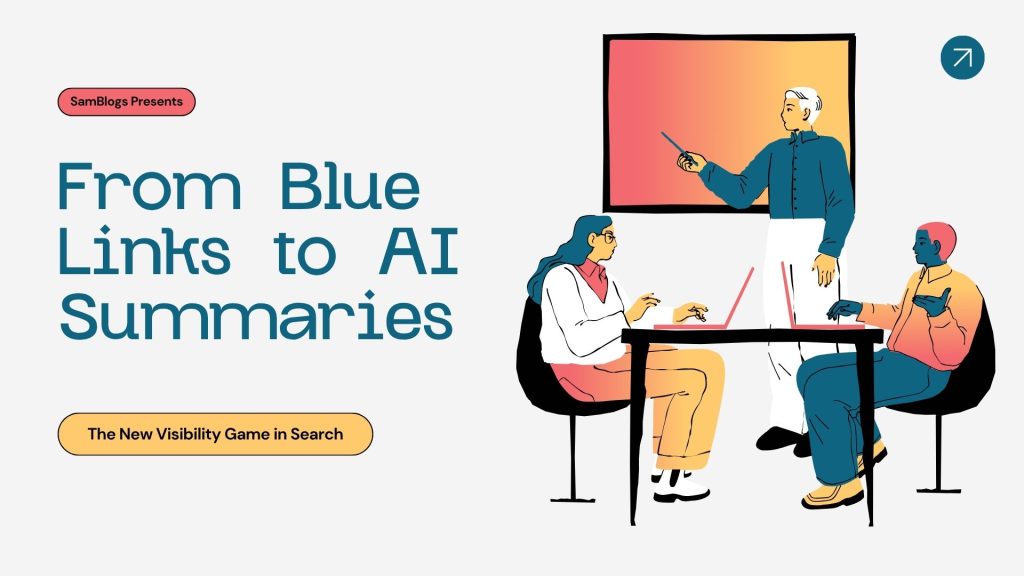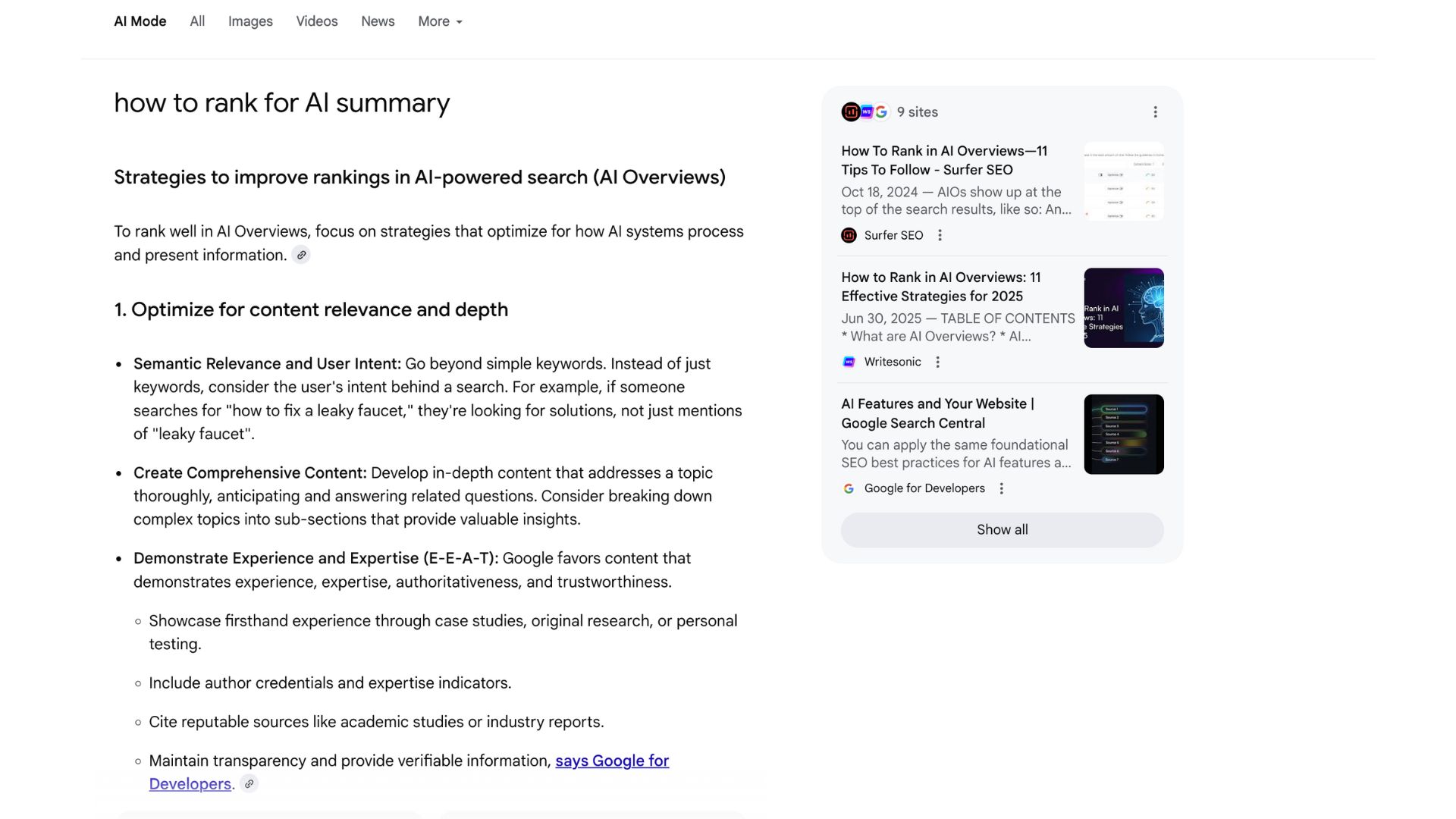The digital environment is changing dramatically. The Search Engine Results Page (SERP) had been the undisputed king of the jungle, the place where websites waged war over getting the cherished blue links that would mean the site holds a high-ranking position. Its objective was simple: climb on top, get the click, and traffic. However, in the recent past, there has been yet another addition to the game with a total change of the rules: Generative AI.
The new visibility game is not simply the ranking game, but it consists of the transmission of the information with the core information that can be synthesized and developed by the AI to provide its answer, basically extinguishing the more primitive clicking. The only way to succeed in this new era is to learn how to transition your thinking from blue links to an AI summary strategy. This shift is not merely an evolution; it is a revolution in the way we picture Search Engine Optimization (SEO) and online presence. In this article, we will explore the new visibility game on the search front, the fundamental change to the way forward in terms of practical action.
Contents
- 1 Understanding AI Summaries and Generative Search
- 2 Blue Links to AI Summaries: Who Controls the AI Answer Box?
- 3 The New Ranking Signals in the AI Search Era
- 4 Optimizing for AI Summaries
- 5 The Role of Entities and Knowledge Graphs
- 6 The Link-Building Shift in the AI Era
- 7 Zero-Click Search & Traffic Strategy
- 8 Future-Proofing Your AI Search Strategy
- 9 Conclusion
Understanding AI Summaries and Generative Search
Large language models are being utilized in trying to rethink search through what is referred to as generative search. Instead of having to wade through a list of links to find an answer, AI-powered search provides a clear, summarized answer in the search results. This is the AI Answer Box, and it is rapidly becoming the web browser of the future.
Such AI summaries are generated by an algorithm that takes information from various sources and extracts the most significant facts, and presents them in a logical, clear-to-understand manner. The essence of this technology is to reduce the user’s efforts and provide a quick response. That equates to the content being original but heavily reliant on the authority and quality of the reference sources.
Blue Links to AI Summaries: Who Controls the AI Answer Box?
Even though it might look like the AI Answer Box is autonomous, it remains under the command of the search engine behind it. Google currently dominates with its Search Generative Experience (SGE), but there are others, such as Bing (which has appended ChatGPT), that are also heavily invested. These are the companies that dictate the algorithms, the ranking signals, and the actual form of the generative answers.
To set the record straight regarding who dominates the AI Answer Box, it is pivotal to classify the key players and the problems they are particularly concerned about:
Google Search Generative Experience (SGE)
As the flagship of the search engine industry, Google exemplifies a search engine company that deploys generative AI to enhance the conversational search experience. Existing Google algorithms, which have always been keen on E-E-A-T (Experience, Expertise, Authoritativeness, and Trustworthiness), have never been more critical than now. A site that needs to be selected as a source of an SGE summary exhibits unmatched credibility and depth on the subject.
Bing and Its Integration with ChatGPT
Microsoft, powered by Bing, seems to follow the model of integrating a powerful large language model into its search experience, ChatGPT. This will bring about the same kind of behavior where the AI will also overflow information and respond conversationally. Bing generative outcomes also appreciate well-organized, neat, and quality sources and websites that can effectively enable the AI to render information and reveal it.
AI Summary Business
AI summary business is not only a technical challenge, but the determination of what to put in an AI summary is a business decision. The search engines always play a tug of war between user satisfaction and the need to make the web healthier. This means they are more likely to post on established and reliable sites, as it aligns with their agenda to provide quality information. A handy tool that can be used as a weapon in these companies is the answer box driven by AI, which helps describe what is authoritative and reliable on the Internet.
The New Ranking Signals in the AI Search Era
Everything was clear-cut in the old SERP universe: backlinks, keywords, on-page optimization, site speed, and so on. Even though many of them remain essential, new sets of necessary signals are emerging with the age of AI search. The latest game is not about how many links a human possesses, but rather who has the greatest authoritative information.
New ranking signals to consider are:
- Topical Authority: Search engines are getting much better at understanding not just keywords but entire topics. You must master and know everything about a subject, and not a single word, to be ranked. This is achieved by developing a grouping of content that is interrelated and addresses the topic from all aspects.
- Readability: The AI should be in a position to read what you post with no difficulty. Keep your headings and data concise, and ensure the data is clearly organized into sentences. Your content should be given as a learning source to the AI.
- Fact-Based Writing: AI summaries contain lots of facts that can be supported. It is also important that whatever you write must be accurate, well-researched, and supported with sound sources. Unsubstantiated claims would not pass the selection of a summary.
- Unique Insights: The AI is looking for unique and valuable information. If your work merely repeats what can already be found, it won’t be selected. Offering a unique perspective or a higher level of analysis is a great advantage.
Optimizing for AI Summaries
To become AI summary optimized, you need to take a strategic turn away from keyword optimization towards concept and answer optimization. You need to write like a human but think like an AI reader. These are some strategies you need to follow:
- Answer Key Questions Up Front: Begin with your writing by answering key questions directly about your subject. To illustrate, rather than beginning with a lengthy introduction, start with: What is an AI summary? An AI summary is.
- Use Structured Data: Utilize structured data (e.g., schema markup) to inform search engines about your content. In this way, your information would be easier to scan and read by the AI.
- Build “Hub” and “Spoke” Content: Write a central “hub” page on a general topic, and then write “spoke” pages on specific subtopics. This layout indicates to the AI that you are the authority on the general subject.
- Use Lists and Tables: Use lists and tables so that the information is neat. The use of lists (bullet or numeric) and tables will enable the AI to grasp vital facts and figures.
- Prioritize E-E-A-T: The E-E-A-T (Experience, Expertise, Authoritativeness, and Trustworthiness) signals in Google are crucial now more than ever. Ensure you have an authoritative writer, factual content, and that it is hosted on a trustworthy site.
The Role of Entities and Knowledge Graphs
Entities are the most crucial notion of the new search situation. An entity is a particular person, place, thing, or concept that represents a unique thing known to a search engine. Albert Einstein is one such entity, and the search engine knows a great deal about his life, his theories, and his connections to other entities, such as “relativity” and “E=mc².”
Such a relationship complication of a search engine’s knowledge is contained in a Knowledge Graph. It is a humongous database that is graphical in its representation of entities and relations. When AI is summarizing, its knowledge base or knowledge graph is usually consulted.
The new regime regarding AI search necessitates an understanding of how to leverage entities and knowledge graphs. The following are some of the main lessons:
Naming Entities
An entity is not merely a keyword, but a concrete, real-world concept, and as such has attributes and relationships. An example is the keyword ‘apple’, which can refer to the name of the fruit, a company, or a person. An entity gives a straightforward way of understanding which apple you are talking about so that the AI can be certain of what you are talking about. The proper use of entities will eliminate ambiguity and provide clearer signals to the AI.
The Role of a Knowledge Graph
The Knowledge Graph is the intelligence brain that describes the world to an AI. It graphically displays relationships between things. When an AI reads through your content, it searches for such relationships to see how your information is related to its current information.
Optimize for Entity Recognition
To entity-optimize your content, you should label and define key persons, locations, and concepts clearly. Use simple language. For instance, instead of “the search engine,” use “Google.” Instead of “the platform,” use “YouTube.” This makes it easy for the AI to recognize the entities and link your content to them. Furthermore, with structured data such as schema markup, you can label entities explicitly, and the AI will have an even easier time.
The Link-Building Shift in the AI Era
Long-established SEO has always been about link building. Backlinks are not as important as they used to be, but this does not mean that they should be ignored. The previous aim was a high-volume link profile. The focus is now on quality and contextual relevance.
A link is no longer only a vote; it is an indication of an authoritative reputation. The AI is advanced enough to determine the context of a link. A link leading to a very authoritative site in your sphere is of much greater value than dozens of low-quality links. The new link-building tactic must aim at:
- Obtaining Links in Membership Directories: Target outreach to websites that are considered industry leaders. A link from an industry-leading publication or university will significantly improve your authority.
- Strategic Development of Internal Links: Creating a strong internal linking structure enables crawlers (AI and search engine crawlers) to understand the site’s structure and how its contents relate. This helps your topical authority.
- Producing Link-Worthy Content: The most desirable links are those that are earned. Write informative, in-depth, and detailed guides, original research, and exclusive data that are not available on other websites, and thus would want to hyperlink.
Zero-Click Search & Traffic Strategy
Zero-Click Search is one of the most significant implications of the AI Answer Box. At this point, the question raised by a user is answered directly on the results page, making it immediately searchable without the need to click on any links. That may be threatening to companies that depend on search traffic.
But the zero-click does not always mean that it is a loss. It is an opportunity to establish brand presence and power. Being mentioned in an AI summary makes you the trusted source of information. Although it is also possible that a user will not click at this very moment, your brand name becomes anticipated on the correct answer, creating long-term trust and recognition.
Your new traffic strategy should focus on:
Becoming the Authority
Focus on content that provides the most frequent and essential questions of your niche, becoming the go-to AI summary source number one. That implies creating in-depth, expert-curated content that covers topics from multiple facets.
Strategic Gated Content
You may post your essential information, but utilize the AI summary to tease with a topic and then offer a link to further reading or proprietary material behind a sign-up page or paywall. This converts a mundane interaction into a lead generation process.
Brand Building
Clicks are no longer the sole aim; the ultimate goal is brand recognition. The AI Answer Box offers a valuable chance to promote your brand, establishing you as a leader in your industry, even without a direct click. It also comes with consistency, and each of your productions serves as a valuable reference source in the AI overview, building trust that makes your brand synonymous with reliable information.
Local Search Optimization
Zero-click search presents a less significant threat and more of an opportunity to businesses with a physical presence, as they face more competition in local search. Local packs and maps typically provide users with what they need. You can generate foot traffic and phone calls without relying on site clicks by optimizing your Google Business Profile with accurate information, reviews, and updates.
Diversification of Traffic Sources
It is not advisable in the new world to rely solely on one source of traffic. You need to establish a presence in other venues as well. Such diversification will mean that, as long as organic search traffic is declining, your brand will remain present and continue to be visible to your audience.
Future-Proofing Your AI Search Strategy
The AI search terrain has continued to change, and as such, any strategy that is fixated is a deficient one. To make your work future-proof, you need to be both flexible and goal-oriented in producing excellent core material.
- User-Centered: Ultimately, AI aims to be user-centric. Construct materials that can be helpful, thorough, and simple to grasp for human readers. When it works for humans, it will also apply to AI.
- Observing and Modifying: Stay informed about changes to search algorithms and new AI functions. Note the sources that are referred to in AI summaries in your niche and understand the type of analysis that led to the selection of that particular source.
- Diversify Your Channels: Avoid putting all your eggs in one basket by not relying solely on one type of content or search engine. Only build audiences using email newsletters, social media, and others. A well-healthy brand and multi-channeled audience will render you immune to algorithm updates.
Conclusion
The transition between the blue links and AI abstracts is not a small change, but a tectonic shift in the world of SEO. Gone are the days when it was all just about keywords and backlinks. The new game focuses on strategic planning in terms of topical relevance, information salience, and credibility. Understanding entities and optimizing content enables you to adapt your strategy and thrive in the new paradigm.
It is no longer ranking, but being the one whom the AI will trust, the one whom the users are already familiar with, and the one that has dominated your niche. This fresh challenge is ongoing, driven by quality and consistency, but the reward is enormous in terms of brand recognition and long-term outreach. Here, every bit of content you create is a block that can be carried for the long term, driving an evergreen cycle of trust and credibility. Your relationship with human beings and your brand presence on the sites will also help you with AI visibility. For the long term, it makes you the voice of authority in your niche, so you become essentially irreplaceable in an AI-powered search experience.






